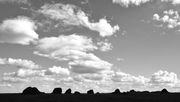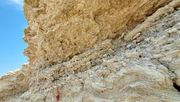Transport Histories of Exotic & Not So Exotic Clasts
COLUMBIA BASIN, WA -- Erratics in the Columbia Basin are rocks of "exotic" lithology brought here by glacial ice, by icebergs rafted in by glacial outburst floods, or by some combination of iceberg rafting and flood transport. Erratics occur as isolated boulders, pebbles in flood deposits, and as mixed piles (bergmounds). They are granite, quartzite, basalt, and a variety of metamorphic rocks formed in distant parts of the Northern Rocky Mountains. People usually find the house-sized boulders more interesting than the pebbles, but they are two sides of the same coin.
The typical explanation of an erratic provided by your Friendly Neighborhood Tour Group Geologist (FNTGG) goes something like this,
“These rocks were plucked from their original position by glaciers to the north and east, transported south and west during the Pleistocene by iceberg-laden outburst floods. They came to rest here, about 200’ from the air conditioned comfort of our chartered bus.”
Special emphasis is always given to an erratic’s great size and how far-traveled it is (tens to hundreds of kilometers!), facts that help punch up the narrative of these great and powerful Missoula floods. But like many aspects of the Missoula floods narrative, there is more to the story.

A given erratic found in the Channeled Scabland may have been plucked from its original (in situ) position, transported south, becoming a bit rounder in the process, just as our FNTGG told us. Alternatively, it could have been weathered and rounded before beginning its flood-borne journey. It might have started in glacial till, in an talus apron, or in an alluvial channel. It could have been picked up and dropped several times by successive outburst floods, bumping its way down the floodway in fits and starts over many decades or millennia.
Two erratics lying side by side in the field - one subrounded, one subangular - may have been brought here by the same flood - perhaps riding inside the same iceberg. But the two may have had very different lives prior to being transport. Thus, they may have very transport histories. How would an erratic look after 1 jump down the floodway? After 6 jumps or 89 jumps? Ice bergs in major rivers in Alaska are routinely sidelined and stranded on mid-channel bars or in side canyons, eventually picked up by highwater flows years later. Some of these stranded icebergs may break up in the warmth of Summer while others may amalgamate and grow larger (more complex) in Winter. In the Arctic today and during glacial periods of the past, some ice bergs and their erratic passengers may have escaped melt of Summer altogether, persisting year round, especially in shadowed canyons.


There is also the matter of "exotic" clasts left behind by the ancestral Columbia River and ancestral Salmon-Clearwater River. These Neogene gravels go by many names - Ellensburg, Ringold, Snipes, Dalles, Troutdale - and have been studied by dozens of geologists over the years (see list below). These Miocene-Pliocene-age sediments were lying about the Columbia Basin long before the arrival of the Pleistocene and its glacial floods.
A quartzite cobble in an outburst flood deposit near Pasco might have come from a Miocene deposit at Snipes Mountain or from a Pleistocene talus apron in western Montana. In fact it came from both places, but a different times. First from western Montana (by rivers). A few million years later floods plucked it from Snipes Mountain and brought it to Pasco (not a promotion). Do you still consider the clast "exotic" if floodwater carried it a few miles across the Columbia Basin?
All that that we can say for sure about that erratic resting on a hillside above town is that it was introduced to the floodway at some time in the past few million years. It may or may not have been weathered or rounded prior to being swept downstream. It may not have come from Montana in one trip.
Studies of Neogene Sediments of the Columbia Basin
Russell 1893, Bretz 1917, Buwalda and Moore 1927, Piper 1932, Allen 1932, Culver 1937, Warren 1941, Hodge 1938/1942, Lowery and Baldwin 1952, Waters 1955/1961, Laval 1956, Makin 1961, Bond 1963, Trimble 1963, Hodgenson 1964, Schmincke 1964/1967, Newcomb 1966/1971, Newcomb et al. 1972, Bentley 1977, Kent 1978, Rigby et al. 1979, Swanson et al. 1979, Bentley et al. 1980, Forooqui et al. 1981, Tallman et al. 1981, Beeson and Tolan 1984, Hagood 1986, Dames and Moore 1987, Fecht et al. 1987, Smith 1988, Smith et al. 1989, Lindsey 1996, Tolan et al. 2002, Evarts et al. 2009, Reidel and Tolan 2009
























